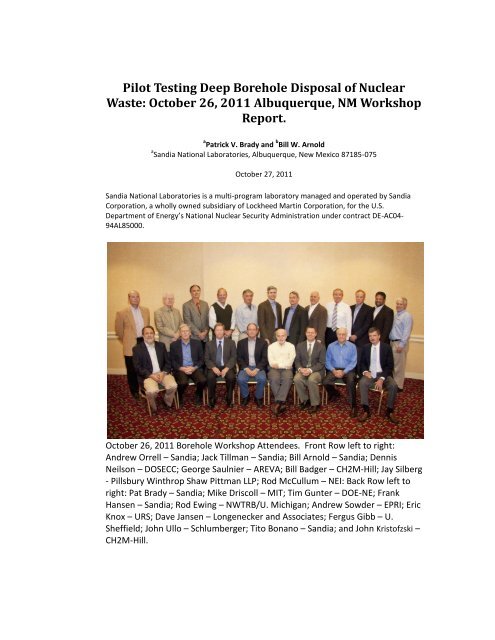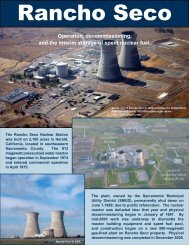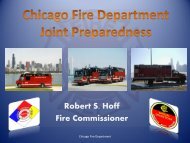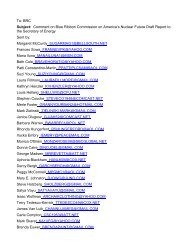Deep Borehole Disposal of Nuclear Waste: Report from a Sandia ...
Deep Borehole Disposal of Nuclear Waste: Report from a Sandia ...
Deep Borehole Disposal of Nuclear Waste: Report from a Sandia ...
Create successful ePaper yourself
Turn your PDF publications into a flip-book with our unique Google optimized e-Paper software.
Pilot Testing <strong>Deep</strong> <strong>Borehole</strong> <strong>Disposal</strong> <strong>of</strong> <strong>Nuclear</strong><br />
<strong>Waste</strong>: October 26, 2011 Albuquerque, NM Workshop<br />
<strong>Report</strong>.<br />
a Patrick V. Brady and b Bill W. Arnold<br />
a <strong>Sandia</strong> National Laboratories, Albuquerque, New Mexico 87185-075<br />
October 27, 2011<br />
<strong>Sandia</strong> National Laboratories is a multi-program laboratory managed and operated by <strong>Sandia</strong><br />
Corporation, a wholly owned subsidiary <strong>of</strong> Lockheed Martin Corporation, for the U.S.<br />
Department <strong>of</strong> Energy’s National <strong>Nuclear</strong> Security Administration under contract DE-AC04-<br />
94AL85000.<br />
October 26, 2011 <strong>Borehole</strong> Workshop Attendees. Front Row left to right:<br />
Andrew Orrell – <strong>Sandia</strong>; Jack Tillman – <strong>Sandia</strong>; Bill Arnold – <strong>Sandia</strong>; Dennis<br />
Neilson – DOSECC; George Saulnier – AREVA; Bill Badger – CH2M-Hill; Jay Silberg<br />
- Pillsbury Winthrop Shaw Pittman LLP; Rod McCullum – NEI: Back Row left to<br />
right: Pat Brady – <strong>Sandia</strong>; Mike Driscoll – MIT; Tim Gunter – DOE-NE; Frank<br />
Hansen – <strong>Sandia</strong>; Rod Ewing – NWTRB/U. Michigan; Andrew Sowder – EPRI; Eric<br />
Knox – URS; Dave Jansen – Longenecker and Associates; Fergus Gibb – U.<br />
Sheffield; John Ullo – Schlumberger; Tito Bonano – <strong>Sandia</strong>; and John Krist<strong>of</strong>zski –<br />
CH2M-Hill.
Introduction<br />
On October 26, 2011 <strong>Sandia</strong> National Laboratories brought together twenty<br />
representatives <strong>from</strong> the fields <strong>of</strong> radioactive waste disposal and drilling to:<br />
review the state <strong>of</strong> deep borehole science and engineering; identify the<br />
necessary features <strong>of</strong> a deep borehole pilot demonstration; and consider<br />
organizational approaches to implementing a deep borehole pilot. Andrew<br />
Orrell (<strong>Sandia</strong>) presented an overview <strong>of</strong> <strong>Deep</strong> <strong>Borehole</strong> <strong>Disposal</strong> with a<br />
discussion <strong>of</strong> the vision and model for creating an industry/lab/academia<br />
consortium to pursue a demonstration, followed by a discussion <strong>of</strong> borehole<br />
pilot testing at the Climax stock in Nevada in the early 1980’s (Brady – <strong>Sandia</strong>),<br />
then a description <strong>of</strong> a recently issued base case reference borehole design<br />
(Arnold, Brady et al. 2011) <strong>from</strong> Bill Arnold (<strong>Sandia</strong>). Mike Driscoll (MIT) and<br />
Fergus Gibb (Sheffield) outlined alternative designs and novel rock-welding and<br />
sealing approaches (The individual presentations can be found below). A<br />
summary <strong>of</strong> the meeting discussions follows.<br />
Discussion<br />
<strong>Deep</strong> borehole disposal is calculated to be as safe as traditional mined geologic<br />
repositories (Brady, Arnold et al. 2009) but more flexible, less expensive<br />
(Arnold, Brady et al. 2011), and more rapidly implemented. Minus<br />
transportation and licensing costs, borehole disposal is estimated to cost about<br />
$158/kg HM (Arnold, Brady et al. 2011), substantially less than the cost<br />
estimated for Yucca Mountain and possibly less than the current collected<br />
nuclear waste fund fee on a per kg basis.<br />
A significant science and engineering literature <strong>of</strong> deep borehole disposal has<br />
accumulated (see Table 1 and the presentations at the end <strong>of</strong> this report) and<br />
important features <strong>of</strong> the approach have been pilot-tested (Patrick 1986).<br />
Table 1. Partial listing <strong>of</strong> borehole technical articles<br />
Subject<br />
Article<br />
<strong>Borehole</strong> Engineering analysis<br />
(Juhlin and Sandstedt 1989; Juhlin and<br />
Sandstedt 1989; Nirex 2004; Beswick<br />
2008)<br />
<strong>Borehole</strong> geochemistry<br />
(Anderson 2004; Brady, Arnold et al.<br />
2009)<br />
Rock welding for borehole plugging (Gibb, Taylor et al. 2008)<br />
Heat flow<br />
(O’Brein, Cohen et al. 1979; Brady,<br />
Arnold et al. 2009)<br />
Cannister design (Hoag 2006)<br />
<strong>Borehole</strong> support matrices (Gibb, McTaggart et al. 2008)<br />
Site selection for disposal <strong>of</strong> Pu in<br />
(Heiken and al. 1996)<br />
boreholes
Pilot remote handling at the surface (Patrick 1986)<br />
Annealing <strong>of</strong> radiation-damaged waste (Weber, Ewing et al. 1996)<br />
forms in boreholes<br />
Questions central to the piloting and implementation <strong>of</strong> deep boreholes that<br />
were identified by the participants include the following.<br />
• Who will pay for a demonstration<br />
• Where will the demonstration be<br />
• Why did Sweden examine, but not pursue, deep borehole disposal<br />
• How long does the path to demonstration or commercial<br />
implementation need to be Actual drilling will ultimately uncover<br />
unexpected features. Will their subsequent examination be lengthy (as<br />
at Yucca Mountain) and potentially crippling<br />
• What constitutes adequate characterization<br />
• How hard will it be to prove adequate downhole conditions e.g. “old”<br />
H 2 O, high salinities, low permeabilities.<br />
• What is the role <strong>of</strong> engineered barriers<br />
• Is “The deeper you go the less you need to know” an accurate<br />
description <strong>of</strong> deep borehole site characterization<br />
• What are functional & operational requirements for a demonstration;<br />
what should be the balance between science and engineering<br />
• What waste types should be the basis <strong>of</strong> the demo (assemblies vs. rod<br />
consolidation, hot vs. cold, Cs/Sr)<br />
• What will future deep borehole regulations look like<br />
• What legislative /regulatory actions are needed for deep borehole<br />
disposal<br />
• How to address issue <strong>of</strong> retrievability<br />
• How to develop a champion for deep borehole demonstration and<br />
implementation<br />
• What will be the scope <strong>of</strong> a demonstration; for example, demonstrate<br />
drilling vs. demonstrate drilling at a potential disposal site vs. drilling<br />
near a reactor<br />
• What is the extent <strong>of</strong> characterization by pilot discovery holes vs.<br />
emplacement holes needed to demonstrate acceptable conditions<br />
• How much ‘gilding’ <strong>of</strong> a base reference design is needed<br />
• What are the mechanical properties <strong>of</strong> rock welds<br />
• How much logging should/will be done<br />
• How to garner approval to dispose (what is closure) What is the<br />
regulatory framework<br />
• How/when do the utilities get involved Where do they fit in Same<br />
for DOE and/or FedCorp<br />
• What does the operational safety case look like
• What is the narrative that will give the public an accurate picture <strong>of</strong><br />
borehole safety and effectiveness and that can be socialized with<br />
industry for making investments<br />
• How will we organize to tackle the above<br />
Other conclusions <strong>from</strong> the discussion were:<br />
• Keep the design as simple as possible. Use the simple approach to guide<br />
the questions we ask about the site.<br />
• As we pursue a demonstration, we will need to keep building the<br />
database and confidence that downhole conditions are what we assert.<br />
Likewise we need to articulate the case for DBH as ‘faster cheaper<br />
better’.<br />
• A cold demonstration (no actual hot fuel) would be effective and far<br />
easier to implement. It was recommended that a full-scale<br />
demonstration that accommodates PWR sized assemblies be the goal.<br />
• A risk-informed approach might limit open-ended site discovery.<br />
Deciding ahead <strong>of</strong> time what a “bad borehole” is focus site discovery.<br />
• Industry perspective questions additional cost savings gained by rod<br />
consolidation due to complexity and costs.<br />
• Regulation might be done in two steps; initially qualifying a site followed<br />
by testing individual holes against previously established acceptability<br />
criteria and then using licensed technology to implement in a manner<br />
similar to COLs for reactors.<br />
• <strong>Deep</strong> borehole disposal <strong>of</strong> the Cs and Sr <strong>from</strong> Hanford (>30% <strong>of</strong> the<br />
activity) would be a useful first disposal target.<br />
• <strong>Deep</strong> boreholes are not be the solution for all wastes.<br />
• A new waste disposal paradigm is needed because the mined geologic<br />
repository model has features, such as engineered backfill systems,<br />
multi-barriers, and retrievability () that may not apply to deep<br />
boreholes. An analysis needs to be done to show deep boreholes merits<br />
versus mined geologic repositories (or CO 2 sequestration sites).<br />
Conference papers, peer-reviewed articles on deep boreholes would<br />
help.<br />
• How defensible are basic geologic concepts that brine won’t rise<br />
because <strong>of</strong> density stratification, seals will be effective and durable, host<br />
rock is suitably homogeneous<br />
• “The oil and gas industry routinely goes 5 km deep. A demonstration<br />
could be done with the technical/engineering understanding we have<br />
now. You’re 99% done if you show no overpressuring and low<br />
permeabilities. “<br />
• “There are no show-stoppers. Demonstrate that you can drill a hole this<br />
deep and wide, send a cold package up and down a few times and<br />
you’re halfway there.”
• Innovations will be developed in the course <strong>of</strong> a demo that might benefit<br />
carbon sequestration, engineered geothermal, oil and gas.<br />
Consortium to Pursue a DBH Demonstration<br />
The attendees collectively agreed that the technical concept is good, that a hole<br />
<strong>of</strong> sufficient depth and diameter is technically achievable with available<br />
technology (no show stoppers), that a deep borehole demonstration pilot<br />
project is needed and would be extremely valuable to establishing feasibility<br />
credibility with stakeholders and nuclear waste management programs alike. In<br />
addition, participants individually expressed willingness to become part <strong>of</strong> a<br />
<strong>Deep</strong> <strong>Borehole</strong> Consortium to organize and implement a pilot demonstration.<br />
Splitting the coalition focus in three directions – engineering, science, and<br />
sociopolitical – might be wise. Details <strong>of</strong> the <strong>Deep</strong> <strong>Borehole</strong> Coalition will<br />
require time to be resolved, but a first draft <strong>of</strong> a vision document, strategic<br />
research agenda, and business plan could be available in spring <strong>of</strong> 2012.<br />
References<br />
Anderson, V. K. (2004). An evaluation <strong>of</strong> the feasibility <strong>of</strong> disposal <strong>of</strong> nuclear waste in very deep<br />
boreholes. Dept. <strong>of</strong> <strong>Nuclear</strong> Engineering. Cambridge, MA, MIT.<br />
Arnold, B. W., P. V. Brady, et al. (2011). Reference Design and Operations for <strong>Deep</strong> <strong>Borehole</strong><br />
<strong>Disposal</strong> <strong>of</strong> High-Level Radioactive <strong>Waste</strong> SANDIA REPORT SAND2011-6749.<br />
Beswick, J. (2008). "Status <strong>of</strong> Technology for <strong>Deep</strong> <strong>Borehole</strong> <strong>Disposal</strong>. Contract No. NP 01185,<br />
EPS International.".<br />
Brady, P. V., B. W. Arnold, et al. (2009). <strong>Deep</strong> <strong>Borehole</strong> <strong>Disposal</strong> <strong>of</strong> High-Level Radioactive<br />
<strong>Waste</strong>. Albuquerque, NM and Livermore, CA, <strong>Sandia</strong> National Laboratories.<br />
Gibb, F. G. F., N. A. McTaggart, et al. (2008). "High-density suport matrices: Key to the deep<br />
borehole disposal <strong>of</strong> spent nuclear fuel." J. <strong>of</strong> <strong>Nuclear</strong> Materials 374: 370-377.<br />
Gibb, F. G. F., K. J. Taylor, et al. (2008). "The ‘granite encapsulation’ route to the safe disposal <strong>of</strong><br />
Pu and other actinides." J. <strong>of</strong> <strong>Nuclear</strong> Materials 374: 364-369.<br />
Heiken, G. and e. al. (1996). Disposition <strong>of</strong> excess weapon plutonium in deep boreholes – site<br />
selection handbook. Los Alamos, NM, Los Alamos National Laboratory.<br />
Hoag, C. I. (2006). Canister design for deep borehole disposal <strong>of</strong> nuclear waste. Dept <strong>of</strong> <strong>Nuclear</strong><br />
Engineering. Cambridge, MA, MIT. M.S.<br />
Juhlin, C. and H. Sandstedt (1989). Storage <strong>of</strong> nuclear waste in very deep boreholes: Feasibility<br />
study and assessment <strong>of</strong> economic potential. Part I Geological considerations. Part II<br />
Overall facilities plan and cost analysis.<br />
Juhlin, C. and H. Sandstedt (1989). Storage <strong>of</strong> nuclear waste in very deep boreholes: Feasibility<br />
study and assessment <strong>of</strong> economic potential. Part I: Geological considerations. Part II:<br />
Overall facility plan and cost analysis., Svensk Karnbranslehantering AB.<br />
Nirex (2004). A Review <strong>of</strong> the <strong>Deep</strong> <strong>Borehole</strong> <strong>Disposal</strong> Concept for Radioactive <strong>Waste</strong>, Nirex-UK.<br />
O’Brein, M. T., L. H. Cohen, et al. (1979). "The Very <strong>Deep</strong> Hole Concept: Evaluation <strong>of</strong> an<br />
Alternative for <strong>Nuclear</strong> <strong>Waste</strong> <strong>Disposal</strong>, Berkeley, CA, Lawrence Berkeley Laboratory,<br />
LBL-7089.".<br />
Patrick, W. C. (1986). "Spent Fuel Test-Climax: An Evaluation <strong>of</strong> the Technical Feasibility <strong>of</strong><br />
Geologic Storage <strong>of</strong> Spent <strong>Nuclear</strong> Fuel in Granite. UCRL-53702.".<br />
Weber, W. J., R. C. Ewing, et al. (1996). "Performance assessment <strong>of</strong> zircon as a waste form for<br />
excess plutonium under deep borehole burial conditions." Materials Research Society<br />
Symposium Proceedings 412: 25-32.
Andrew Orrell Presentation
DBH Recognition
Rising Visibility (2/2010)
Pat Brady Presentation
Bill_Arnold Presentation
Mike Driscoll Presentation
Fergus Gibb Presentation



![Rainer Schottlaender[SMTP:RAINER.SCHOTTLAENDER@WEB.DE]](https://img.yumpu.com/51418350/1/190x245/rainer-schottlaendersmtprainerschottlaenderwebde.jpg?quality=85)












